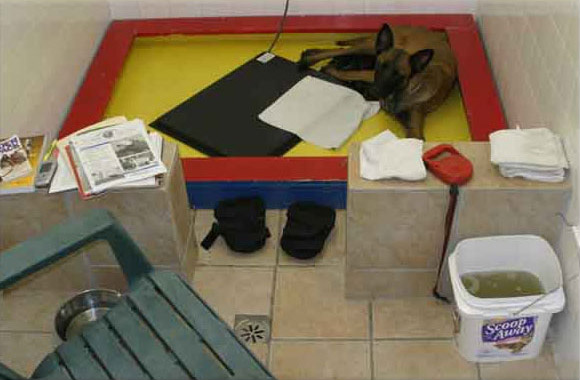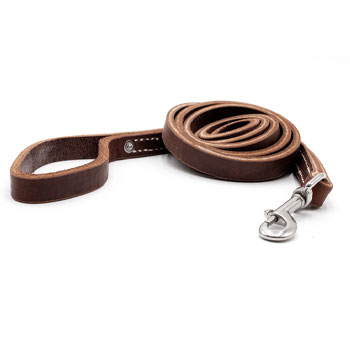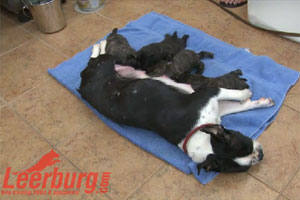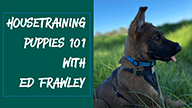A Well-Organized Whelping Room
Note: Leerburg formerly bred working bloodline German Shepherds until deciding to shift its focus towards producing dog training videos and courses alongside providing quality dog training equipment. This article was written when our breeding program was still active. While Leerburg no longer breeds working GSDs, we believe this article may still provide valuable information for those interested in starting their own breeding program.

This photo shows one of our Leerburg whelping rooms in the middle of a Malinois litter being born on July 20, 2005. Here is a list of what we have in our whelping room during the birthing process.
In the Whelping Box
- The room has ceramic tile on the floor and walls for easy cleaning and disinfecting.
- The 4 ft. by 5 ft. whelping box has rails made from 1x6 board (painted red in the photo) so the female cannot squish a puppy that gets behind her and up against the edge of the box.
- The heating pad in the box replaces the need for a heat lamp. These pads are the best thing since sliced bread. We will never again use another heat lamp.
- We keep 3 or 4 small terry cloth hand towels in the box to lay pups on. You can see one sitting on the heating pad. We get these from Sam's Club. Once the litter is born, we put thin indoor-outdoor rugs that allow the pups to get better traction scooting around the box. We throw them away after the litter is weaned out of the box.
- There is a 2-foot divider wall. The purpose is to keep the pups behind the wall when they get big enough to crawl out of the whelping box. There are plastic drop doors that are slid into rails on the back of the wall that are used once the pups can crawl out. This allows the mother to get away from the pups when she needs a break.
On the Divider Ledge
- Reading materials and cell phone to pass the time.
- Hand towel ready to clean out the box or put under the pile of pup.s
- A Flexi Leash ready to take the female out for a walk during the birthing process. Note: We will walk the moms on-leash several times during the process, usually after she has gone 2 hours without a pup. We always take hand towels with us when we walk the female. On more than one occasion, we have had a mother give birth to a pup while we walked her.
Outside of the Whelping Box
- Two black knee pads on the ground waiting for me to kneel down and work with the mom or to get the pups on a nipple.
- Bucket of clean warm water with a little Dreft soap in it to wipe out the whelping box.
- Lawn chair.
- A stainless-steel bowl with clean drinking water. We also keep cans of chicken broth and try and get our females to drink a couple of cans during the process and then every day after, we will offer 2 to 3 cans of beef or chicken broth a day. I get emails all the time from people wondering how to get their bitch to produce more milk after the pups are born. Part of the solution is to get them to drink a lot of liquid. The more liquid she drinks, the more milk she produces.








Ask Cindy.